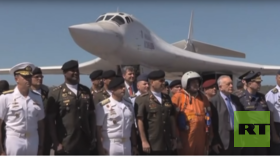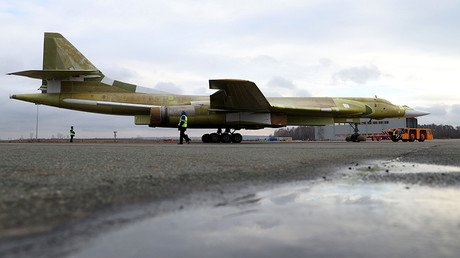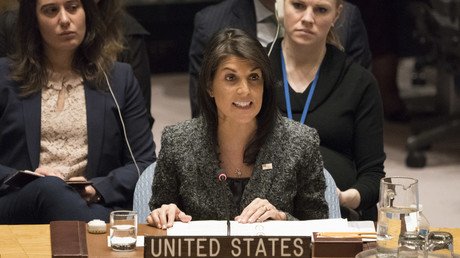Power projection or experimental flight? What Russian Tu-160 bombers actually did in Venezuela

The arrival of two Russian strategic bombers in Venezuela has jangled nerves in Washington and sent western media into meltdown. But the joint drills in the area don’t seem like an actual display of force, one analyst believes.
The nuclear-capable Tu-160 strategic bombers, accompanied by two Russian Air Force heavy transport aircraft, landed in Caracas on Monday, as part of a Russian Air Force group taking part in joint drills with the Venezuelan military. Dozens of Russian pilots and technical staff arrived in the Latin American country to share the experience and get some training.
“That was a good practice for the long-range Air Force crews,” Mikhail Khodarenok, a retired colonel and a military commenter for the Russian Gazeta.ru media outlet, said, commenting on the 10,000-kilometer-long flight over the Atlantic the Russian pilots had just performed. He also explained that the flight of just two bombers was primarily “an experiment” aimed at testing the resolve of the Russian crews and allowing them to hone their skills.
However, a small friendly visit to Venezuela, which, according to Khodarenok did not have much of a “strategic” impact on the situation in the region, still apparently unnerved some bigwigs in Washington. The US State Secretary Mike Pompeo deemed it necessary to scold the event by accusing Russia of “squandering” its public funds and squarely branding Moscow and Caracas as “two corrupted governments.”
Also on rt.com Pompeo blasted for hypocrisy on Twitter after saying Russia ‘squandering’ public funds on military‘Threat to region’?
As brazen as this bravado might seem, it appears that just two Russian bombers made the top diplomat of a world power –the military budget of which is bigger than those of the six next biggest military spenders combined– feel somewhat uncomfortable. Meanwhile, Senator Marco Rubio decided not to beat around the bush and warned that the US should expect Russian planes “entering well into the US air defense identification zone.”
We should expect the two Russian bombers currently in #Venezuela at the invitation of Maduro to conduct a flight that enters well into the U.S. Air Defense Identification Zone in the Gulf of Mexico. Very near to Elgin & Tyndall AFB. pic.twitter.com/q7LUwi9WTL
— Marco Rubio (@marcorubio) December 11, 2018
The senator’s press shop rushed to declare the arrival of the two bombers “alarming” and the drills no less than a “threat to stability in the region and to US national security.”
Alarming that Russia deployed strategic bombers to Maiquetia Airport in #Venezuela days after dictators Maduro and Putin met. This is another example of the threat both regimes pose to stability in the region and US national security. 1/2 https://t.co/7NPslzzVDY
— Senator Rubio Press (@SenRubioPress) December 11, 2018
The scariest facts that, so far, have emanated from Moscow state the two bombers had performed a 10-hour-long flight over the waters of the Caribbean Sea while practicing cooperation with the Venezuelan Air Force and that the Tu-160s were accompanied by the Venezuelan Su-30s and F-16s. The Russian Defense Ministry, in fact, didn’t mention anything related to the US at all.
But media has readily jumped on the bandwagon of another wave of anti-Russian hysteria as this news became headlines on almost all major news outlets. Half of them anxiously warned their readers that Russia’s “long-range … supersonic … nuclear-capable” bombers are already in Venezuela while others seemed to be more concerned that the move had “angered” Washington and led to a new spat in relations between the two great powers.
‘Baseline minimum’ for power projection
For all the fuss that deployment has provoked, it does not come even close to what a real demonstration of force –or “projection of power”, as Washington likes to put it– would potentially look like in reality, Khodarenok believes.
Also on rt.com Kremlin blasts Pompeo’s ‘squandering’ remark, says US military budget ‘enough to support all Africa’For it to be “quite successful,” such muscle-flexing would need to include a heavy bomber division consisting of some 40 aircraft accompanied by more than a hundred of fighter jets, which would be deployed to Venezuelan airfields in a matter of 24 hours, the retired colonel said. He added that a projection of force would have included some Russian Navy battlecruisers or the state-of-the-art Yasen-M multipurpose submarines.
That would by no means be a “threat” to the US or any other nation but only “a demonstration of the military capabilities of a state,” Khodarenok said, qualifying his estimate as “not some off-the-scale figures but a baseline minimum” for the composition of forces.
Notably, that would be still less than the amount of US military hardware that used to take part in the joint drills with South Korea off the Korean Peninsula. In 2016, those war games particularly involved F-22 superiority fighters, strategic bombers, nuclear-powered submarines and amphibious carriers, as well as 15,000 US troops.
The exercises were held not just in the proximity of North Korea – the supposed primary adversary of the two nations in the region – but also not that far from the Russian eastern territories. Still, no one in the West apparently saw those drills as a “threat to stability in the region” even during the latest crisis around the Korean peninsula.
Curiously, it’s not the first time the Russian strategic bombers have been deployed to the Latin American country; two such aircraft already performed a similar flight back in 2008.
Like this story? Share it with a friend!














